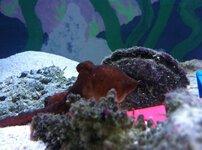- Joined
- Sep 7, 2012
- Messages
- 173
I think you might be right! I was watching her this morning and she doesn't seem to have a pair of eye spots, just random spots that are hard to see. The word "plain" would definitely fit her coloration. (Like anything about an octopus could be considered plain! lol) So far I haven't seen any bold patterns. When she is out, she is always a solid brown and when she does change color it is stays pretty solid.
I read excerpt. Interesting! Am having trouble finding out how big it will get. Also, how did an octopus from Australia wind up in New York with info saying it was from Indonesia? lol!! Does this type of thing happen often? Is this species unusual to see? Pics and info seem to be harder to find than on the other species I was looking up. Maybe it is not as popular because it comes out mostly at night? Sorry for the questions, I just want to be able to make good decissions regarding it's care.
If for some strange reason it did turn out to be a species that gets pretty big, or one that is more unusual, I would be willing to donate it to an appropriate person/place if one was reasonably close by and then find one better suited for a beginner! She is really cool, but I work with many kinds of animals and I am all about what is best for them and for research about them!
I read excerpt. Interesting! Am having trouble finding out how big it will get. Also, how did an octopus from Australia wind up in New York with info saying it was from Indonesia? lol!! Does this type of thing happen often? Is this species unusual to see? Pics and info seem to be harder to find than on the other species I was looking up. Maybe it is not as popular because it comes out mostly at night? Sorry for the questions, I just want to be able to make good decissions regarding it's care.
If for some strange reason it did turn out to be a species that gets pretty big, or one that is more unusual, I would be willing to donate it to an appropriate person/place if one was reasonably close by and then find one better suited for a beginner! She is really cool, but I work with many kinds of animals and I am all about what is best for them and for research about them!



